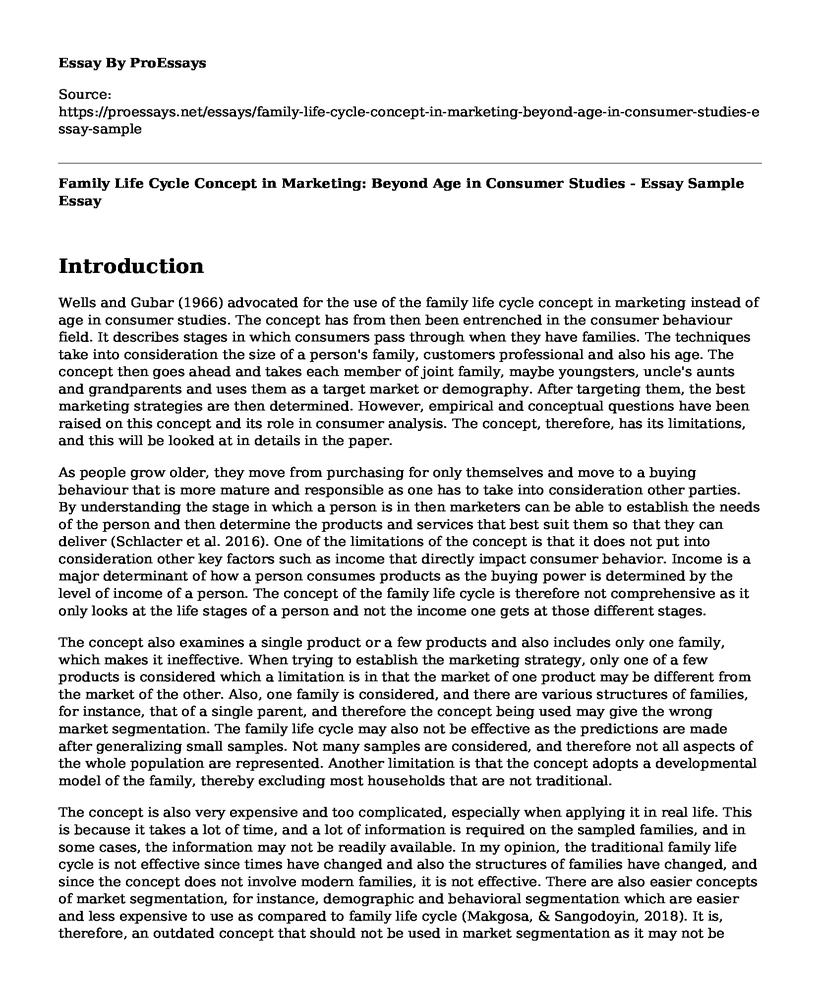Introduction
Wells and Gubar (1966) advocated for the use of the family life cycle concept in marketing instead of age in consumer studies. The concept has from then been entrenched in the consumer behaviour field. It describes stages in which consumers pass through when they have families. The techniques take into consideration the size of a person's family, customers professional and also his age. The concept then goes ahead and takes each member of joint family, maybe youngsters, uncle's aunts and grandparents and uses them as a target market or demography. After targeting them, the best marketing strategies are then determined. However, empirical and conceptual questions have been raised on this concept and its role in consumer analysis. The concept, therefore, has its limitations, and this will be looked at in details in the paper.
As people grow older, they move from purchasing for only themselves and move to a buying behaviour that is more mature and responsible as one has to take into consideration other parties. By understanding the stage in which a person is in then marketers can be able to establish the needs of the person and then determine the products and services that best suit them so that they can deliver (Schlacter et al. 2016). One of the limitations of the concept is that it does not put into consideration other key factors such as income that directly impact consumer behavior. Income is a major determinant of how a person consumes products as the buying power is determined by the level of income of a person. The concept of the family life cycle is therefore not comprehensive as it only looks at the life stages of a person and not the income one gets at those different stages.
The concept also examines a single product or a few products and also includes only one family, which makes it ineffective. When trying to establish the marketing strategy, only one of a few products is considered which a limitation is in that the market of one product may be different from the market of the other. Also, one family is considered, and there are various structures of families, for instance, that of a single parent, and therefore the concept being used may give the wrong market segmentation. The family life cycle may also not be effective as the predictions are made after generalizing small samples. Not many samples are considered, and therefore not all aspects of the whole population are represented. Another limitation is that the concept adopts a developmental model of the family, thereby excluding most households that are not traditional.
The concept is also very expensive and too complicated, especially when applying it in real life. This is because it takes a lot of time, and a lot of information is required on the sampled families, and in some cases, the information may not be readily available. In my opinion, the traditional family life cycle is not effective since times have changed and also the structures of families have changed, and since the concept does not involve modern families, it is not effective. There are also easier concepts of market segmentation, for instance, demographic and behavioral segmentation which are easier and less expensive to use as compared to family life cycle (Makgosa, & Sangodoyin, 2018). It is, therefore, an outdated concept that should not be used in market segmentation as it may not be effective.
The traditional family life cycle is a method of market segmentation where families are considered and thee different life stages of a person. The method has a number of limitations such as it fails to consider income factor, it is expensive and time-consuming, it only examines one product and also it generalizes small samples. The concept is, therefore, not effective compared to other methods of market segmentation such as demographic segmentation.
References
Makgosa, R., & Sangodoyin, O. (2018). Retail market segmentation: the use of consumer decision-making styles, overall satisfaction and demographics. The International Review of Retail, Distribution and Consumer Research, 28(1), 64-91.
Schlacter, J., Razzouk, N., & Mills, M. (2016). The family life cycle revisited. In Proceedings of the 1979 Academy of Marketing Science (AMS) Annual Conference (pp. 38-42). Springer, Cham.
Cite this page
Family Life Cycle Concept in Marketing: Beyond Age in Consumer Studies - Essay Sample. (2023, May 12). Retrieved from https://proessays.net/essays/family-life-cycle-concept-in-marketing-beyond-age-in-consumer-studies-essay-sample
If you are the original author of this essay and no longer wish to have it published on the ProEssays website, please click below to request its removal:
- Essay Sample on Ethnography About People Behavior in Grocery Store
- How These Five-Star Hotels in Morocco Can Improve on the Various Products They Offer Using Customer Satisfaction
- Paper Example on Brand Identity of the Merged Companies
- Dove's Advertising Campaign Critical Essay
- Strengthening Household Appliances Supply Chain Risk Management - Essay Sample
- Coffee Demand Soars: Supply Chain Management Innovates to Compete - Free Paper
- Driving Success: Analyzing the Costs and Benefits of Employee Motivation at Vroomz Company - Paper Example







